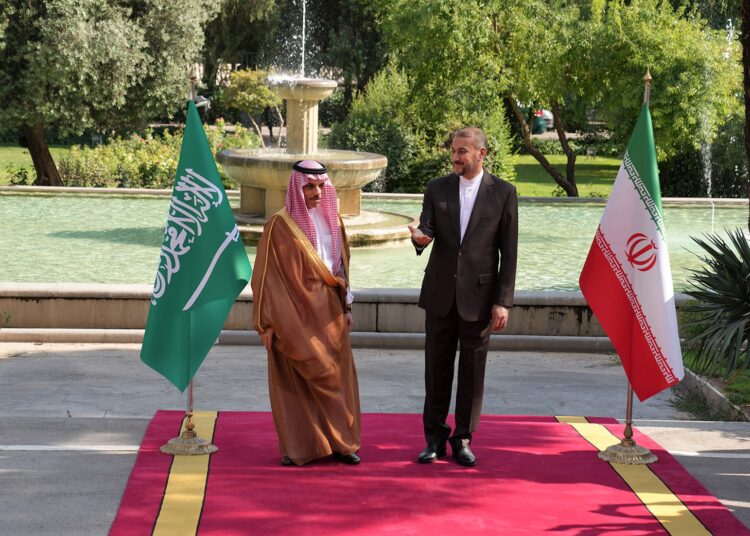The dynamic between Iran and Saudi Arabia has always been a tri-dimensional puzzle, far more complex than a mere bilateral relation.
By: Abas Aslani
Two decades removed from the conception of the term “Shia Crescent”, employed in reference to Iran’s regional policies, the intense rivalry and distrust between Iran and Saudi Arabia reached fever pitch. Yet, recently, these historical foes finally extended the olive branch, hinting a “crescent of friendliness” could possibly dawn in the political firmament of Iran-Saudi relations. Over the last seven years, the fraught relations between these regional powers had escalated to such heights that the decision to reestablish their diplomatic ties and revert to previous levels of political relations, left many observers stunned. More intriguingly, Tehran and Riyadh signal an aim that stretches beyond merely de-escalation, hinting at a future of hitherto unprecedented collaboration and convergence.
The quandary lies in the normalization of frayed relations, which at face value might appear a logical progression between the nations, yet for Tehran and Riyadh, it begs the questioning of a dramatic change and their sudden rapprochement. Which raises the question – will this newfound amicable trend hold its course? Or is the rekindling of the combustible Iran-Saudi strife a foregone conclusion poised to taint relations again? Will this reset of Iran-Saudi relations act as a catalyst for transformation amongst Arab nations regionally, or even more broadly? Or will the circumstances, both regional and international, sway Tehran, Riyadh relations?
All these inquiries tread on the familiar path of historical precedents, invoking the suspicion of a third player influencing Iran and Riyadh connections. The dynamic between Iran and Saudi Arabia has always been a tri-dimensional puzzle, far more complex than a mere bilateral relation.
The American factor
Post the Islamic Revolution in Iran, the US’s Twin Pillars policy in the Middle East came to a decisive end. Over the succeeding four decades, Saudi Arabia didn’t merely serve as a bulwark for the US against Iran, but also as a vital ally, aiding the US in maintaining hegemony in the Middle East and the world.
The strengthening ties between Saudi Arabia and China, coupled with the thawing of Iran-Saudi relations, delivers a crippling, one-two punch to the United States’ long-held strategy in the Middle East. Historically, for political, economic, and military reasons, Saudi Arabia acted as a guardian of the United States’ interests within this strategically critical region. Now, in one of the most pivotal periods of US global politics, Iran and Saudi Arabia have emerged as converging arcs, bolstered increasingly by China’s expanding regional influence, all of it at the expense of traditional US interests.
Although initial reports suggested Washington was caught blindsided by the Iran-Saudi agreement, in subsequent public pronouncements, the US acknowledged the normalizing Iran-Saudi relations as a positive development. Though this had happened under China’s auspices. Washington can’t help but understand the complications that this alignment poses for US hegemony in the region.
The crucial aspect lies in the newfound atmosphere defining Iran-Saudi relations, where the avenues for the US to maneuver the circumstances to its advantage are constricted. Previous reasons which ensured Saudi compliance vis-à-vis Iran included the concern over Iranian military power, Washington’s unconditional support for Saudi regional policies, and the US’s non-interference stance in Saudi’s internal politics. Riyadh had long harbored misgivings over possible Washington entanglement in its internal affairs and power conflicts. It appears, with the consolidation of Mohammed bin Salman’s power, socio-economic reforms are underway. Coupled with the reshaping of international corridors of power, the growing concerns for the US, and the receding American focus on the Middle East, the power of the US to meddle in Saudi affairs has significantly diminished. This lends greater confidence to Riyadh, enabling a more autonomous approach in their foreign policy.
Consequently, a revaluation of America’s diplomatic toolkit in its Middle East policy is not merely anticipated, but necessitated. There is an argument among American analysts advocating for a pivot towards economic relations in Washington’s dealings with the Middle East. Notwithstanding, the deep-rooted military-security tenet that has underscored the US approach toward the region is unlikely to undergo any immediate transformations. In actuality, even if economic incentives are doled out to some nations, security remains the lynchpin of Washington’s policy in the Middle East.
Multiple scenarios might be envisaged, conjecturing the evolving American policy in the Middle Eastern quagmire. The salient question hinges on whether peace and stability, which ostensibly facilitate Chinese capital advancement in the region, align with the strategic best interests of the United States. Indeed, dovetailing with America’s diminished economic dependence on the region, one might presume a broader US withdrawal from the Middle East serves Washington’s agenda. However, a region plagued by instability represents an opportunity for the United States, germinating fertile soil for renewed proxy conflicts, thus unsettling the regional equilibrium. Such developments wouldn’t hold aloof from impacting the budding relations between Iran and Saudi Arabia. Particularly in the backdrop of the global realignment of power, America’s immediate imperative is to counteract Russia while bolstering alliances on both sides of the Atlantic.
Washington’s recalibrated Middle East policy could take off under the auspices of a new power locus in the region. Alternatively, it could stem from new crises within the region, that could disrupt the intersecting interests of key players such as Iran and Saudi Arabia, propelling their policies from cooperation back towards confrontation.
Stress-testing Israeli calculations
The influence of Israel in the shaping of Iran-Saudi relations is too consequential to be sidelined. The Abraham Accord strove not merely toward achieving normalized diplomatic relations of Israel with other Persian Gulf nations but ambitiously envisaged a comprehensive Arab-Israeli union against Iran. The resurgence of Tehran-Riyadh relations has indeed muddled Tel Aviv’s diplomatic equations. Predicated on a balance of threats against Iran, a cornerstone of Israel’s Middle Eastern diplomatic strategy in regards to Saudi Arabia is currently being stress-tested. Tehran and Riyadh now display an evolving threat perception which could potentially strain Israel’s policy. The likelihood that Iran-Saudi relations might be leveraged by Riyadh against Tel Aviv is distinct. Yet, caution must be advised against negating the influence of the Israeli lobby in sparking renewed tensions between Iran and Saudi Arabia.
A new agenda for the Axis of Resistance
As regional rivals, Iran and Saudi Arabia have inevitably clashed on various regional issues. Their ongoing rapprochement has exhibited a positive sway on several of these disputes, notably in the Yemen conflict and more recent developments regarding normalization with Syria. The burgeoning impetus amongst other Arab nations for improved relations with Iran cannot be underestimated either. Aided by the ongoing, albeit tacit, understandings, Saudi Arabia’s threat perception emanating from the Shia Crescent might experience a relative decrease in the foreseeable future. In the shifting regional dynamics, the resistance axis seems increasingly centered on the Palestine issue, which could facilitate further alignment between Iran and Saudi Arabia regionally, and within the Organization of the Islamic Conference. The conspicuous US retreat from the Middle East plays a vital role in fostering these developments.
Chinese priority and likely American hurdle
Securing its energy supply and promoting its economic ventures within the Middle East and globally are vital pivots of China’s foreign policy. Hence, peace and stability in the Middle East encompass a priority for Beijing. Fundamentally, China can serve as a positive influence in improving cooperation and relations between Iran and Saudi Arabia. Yet, it would necessitate increased Chinese control over regional power intricacies, thereby amplifying Beijing’s maneuverability within the Middle East. Concurrently, potential American policies that are financially burdensome for Beijing might complicate the situation.
Russian divergent interests
Pertaining to Russia’s stance and potential influence in the future trajectory of Iran-Saudi relations, it’s incumbent to take note of its multifarious and historically entrenched interests in the region. The provenance of Russia’s fascination with the Middle East harks back to the epochs of its past empires. In the Soviet era, Egypt, Syria, and Iraq were couched as strategic cohorts of Russia in the Middle Eastern chessboard. Hence, Russia’s support, concomitant with Iran, of Bashar al-Assad’s government in Syria can be decoded as a bid to conserve its final outpost. Concurrently, Moscow and Tehran’s efforts to cement strategic ties can be viewed through the prism of Russia’s growing blueprint in the Middle East. However, Russia navigates a thicket of divergent interests in the Middle East, some of which clash with Iran’s objectives. This mismatch occasionally ignites disagreements between Tehran and Moscow and the Arab nations of the region, most notably Saudi Arabia, the United Arab Emirates, and Qatar. Essentially, a marginal degree of discord and distance between Iran and Saudi Arabia can be interpreted as favorable to Russia. In other terms, a comprehensive resolution of Iran-Saudi differences may render Russia’s operational bandwidth in the Persian Gulf more constricted. The recent instance of Russia’s endorsement of the Persian Gulf states’ statement against Iran’s territorial sovereignty regarding the trio of islands – Abu Musa, Greater Tunb, and Lesser Tunb – bolsters this premise.
Conclusion
Despite Beijing’s instrumental role in dousing the tension between Tehran and Riyadh, it can be assessed that China primarily catalyzed the process between Iran and Saudi Arabia, thereby greasing the wheels of normalization. Posterior to a few months, it’s apt to surmise that the de-escalation within the Iran-Saudi relationship was endogenously driven. On this basis, a cautious optimism can be vested in Tehran and Riyadh’s intent to avoid cycling back into historical conflictual trajectories.
Iran and Saudi Arabia’s divergences are manifest across a multitude of areas stretching from bilateral matters to regional conflicts. Though, it’s plausible that the rivalry between both nations has evolved beyond the zero-sum impasse. Ostensibly, the subjective underpinnings guiding Tehran and Riyadh’s perception of threat balance seems to have attenuated, potentially fostering enhanced mutual restraint against factors detrimental to their relationship. Nonetheless, the transition into a positive-sum paradigm remains questionable. The power equilibrium continues unabated. A fortification of Iran-Saudi ties mandates eschewing provocative signals, advocating incremental improvement gestures, and chalking out bilateral ventures that ensure relationship durability.
Presumably, some of these steps will be orchestrated during impending diplomatic rendezvous. Aligning with diplomatic customs, Saudi Arabia is poised to host Iranian officials during the subsequent round. During the Saudi Foreign Minister’s sojourn to Tehran, conjectures emerged that Iranian President Ebrahim Raisi had been invited to Saudi Arabia. Albeit, one mustn’t discount the role of external influences in brewing a pessimistic atmosphere between Tehran and Riyadh. It bears mention that post-agreement, particular parties exerted pressure on the Saudi side due to its relaxing relationship with Iran.
The views expressed in this article are those of the author and do not necessarily reflect the positions of Iran Nuances.







Comments 1